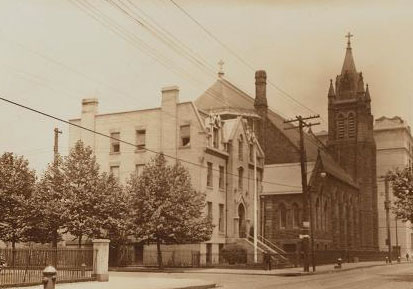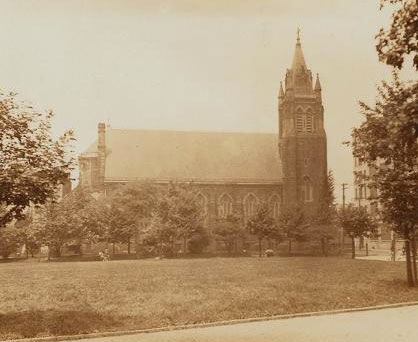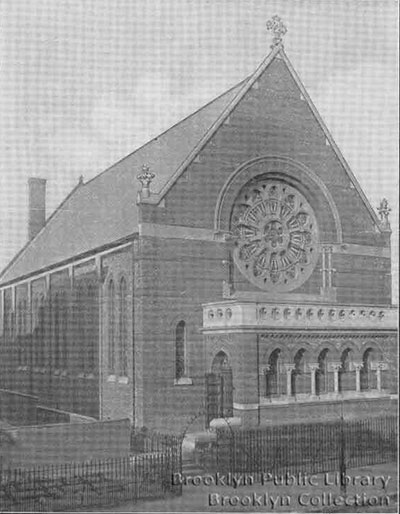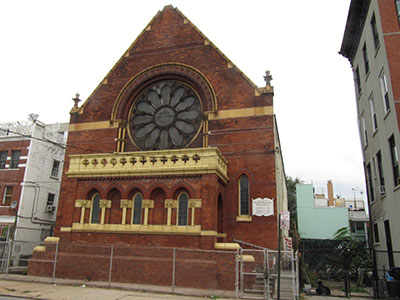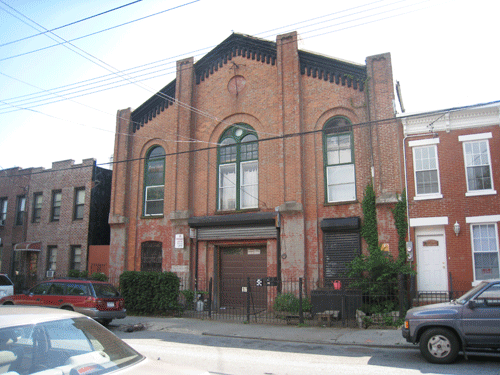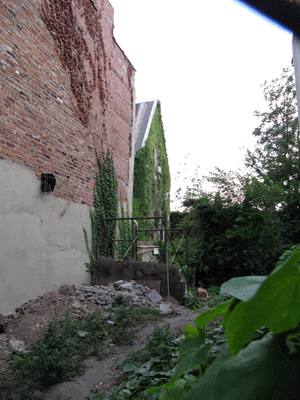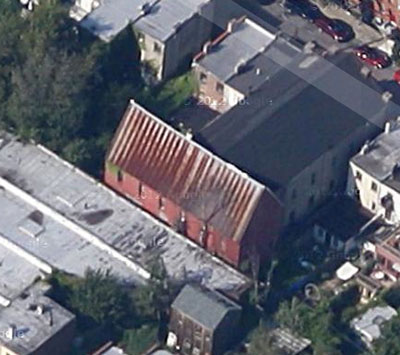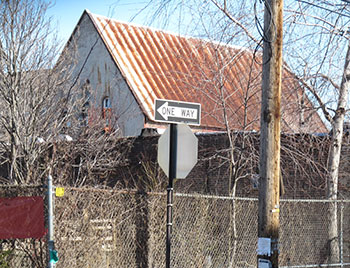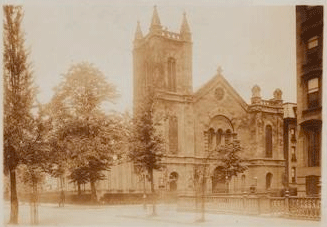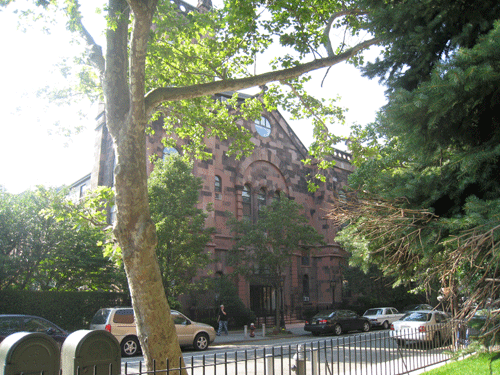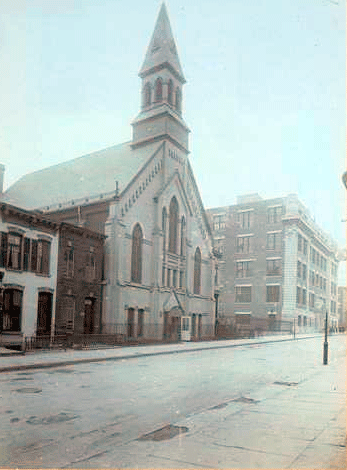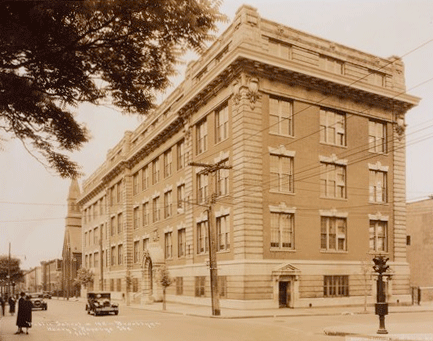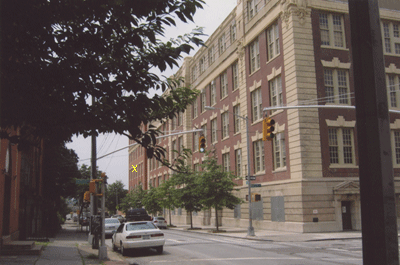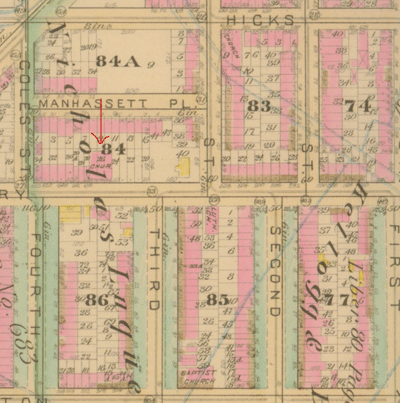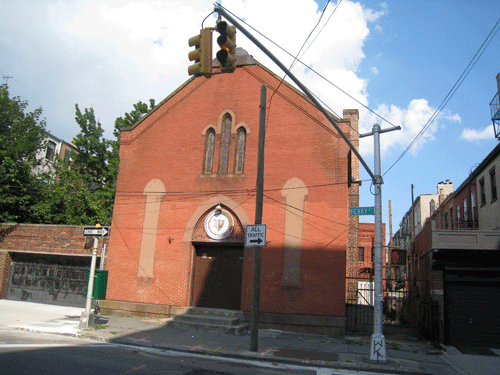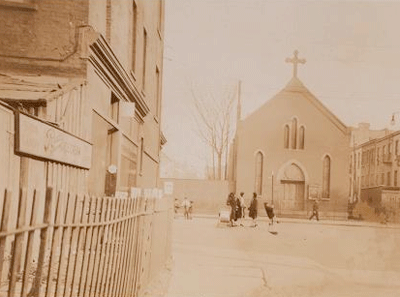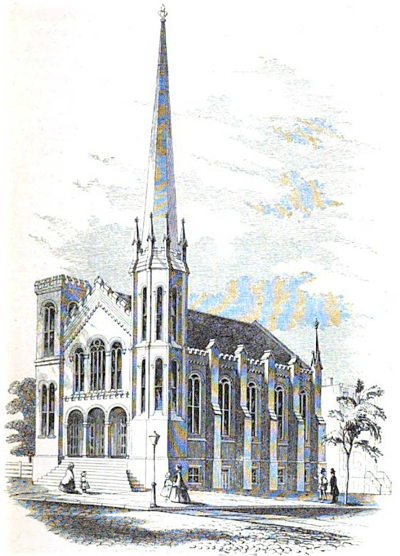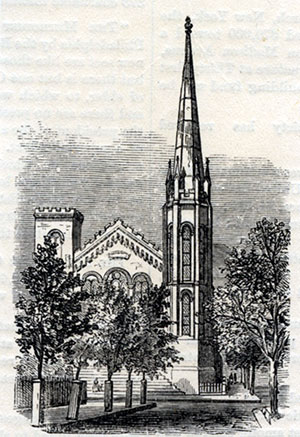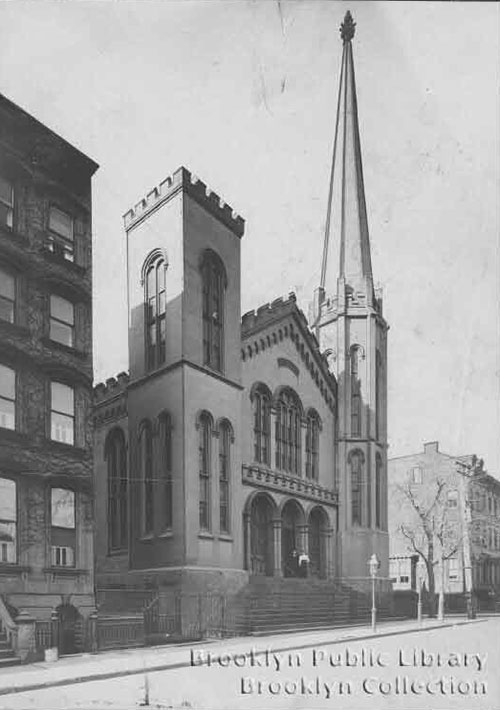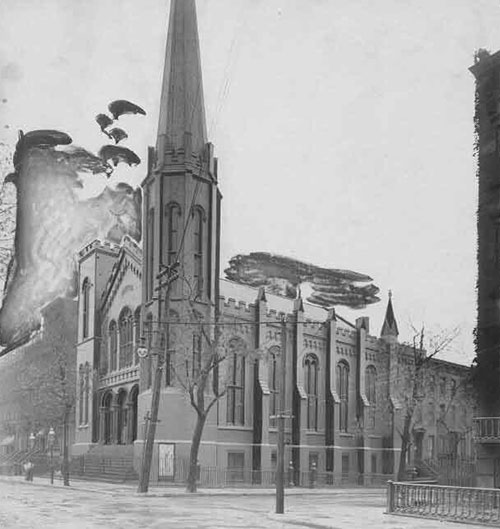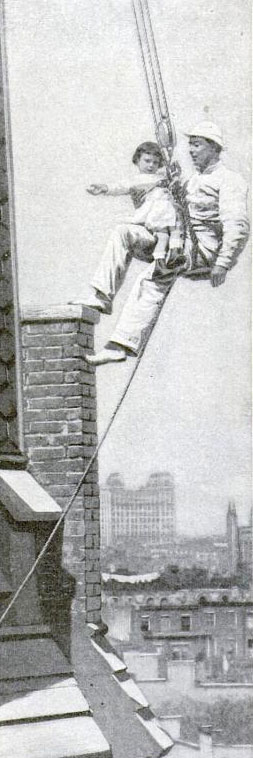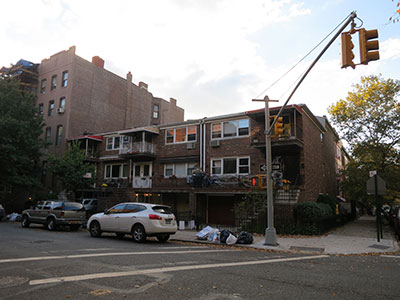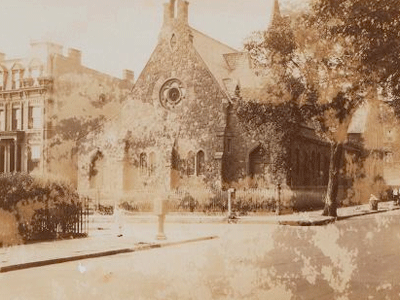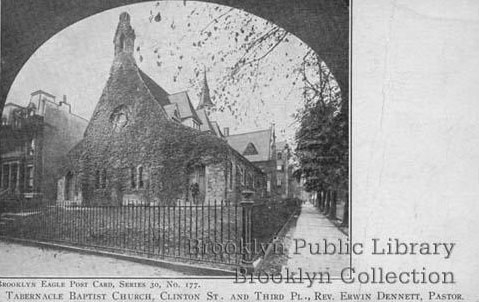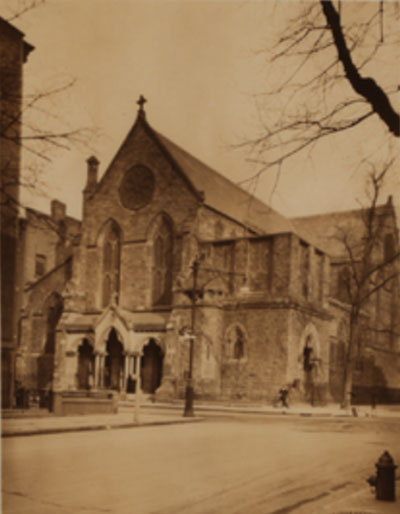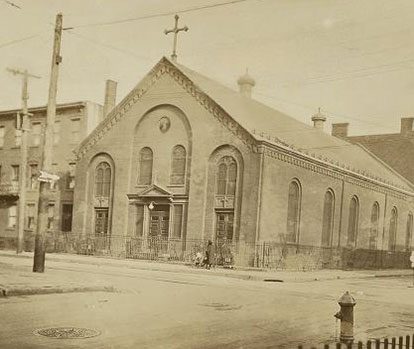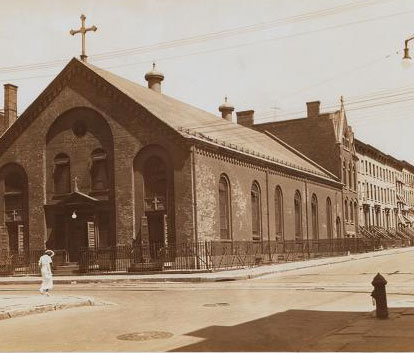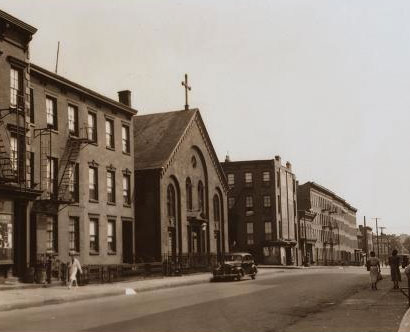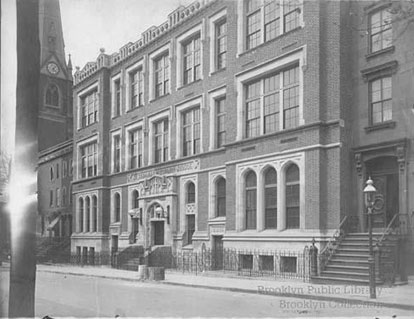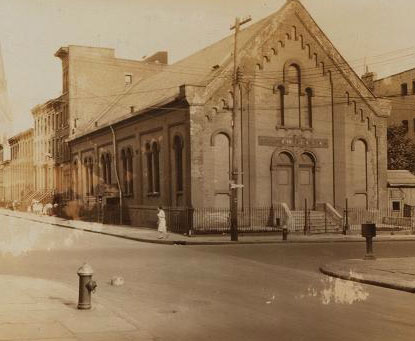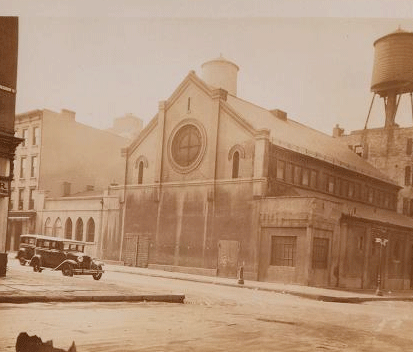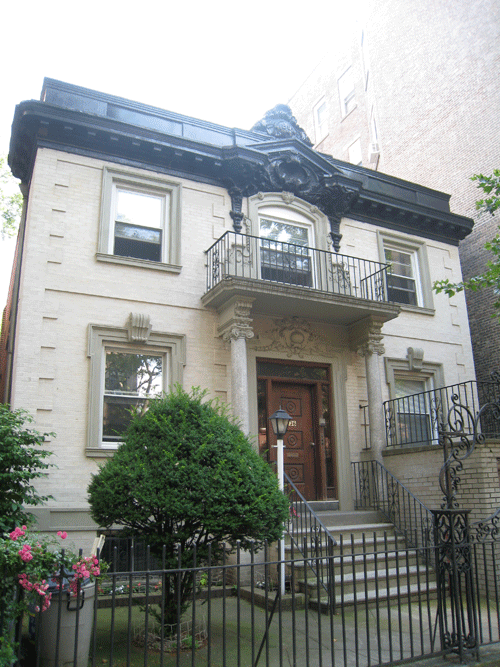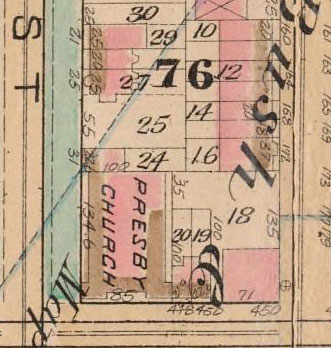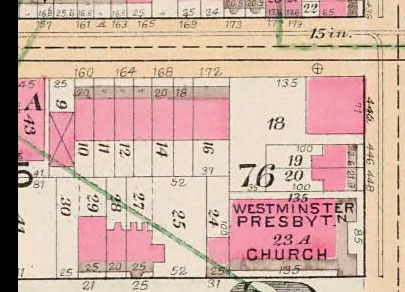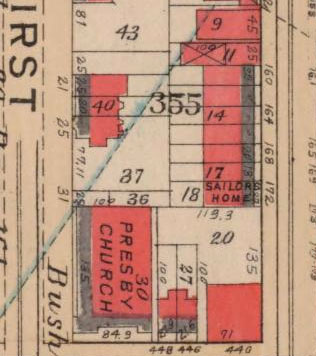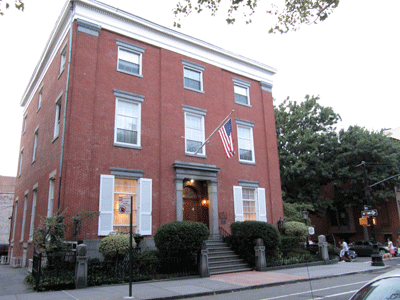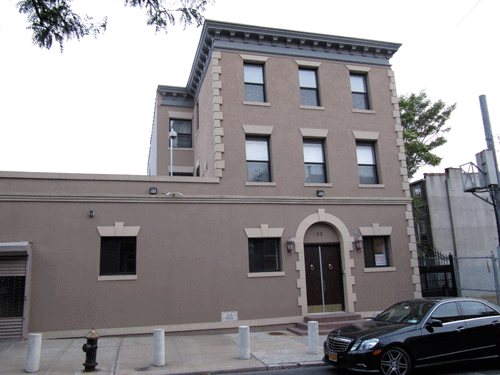| Scandinavian Sailor's Temperance Home - The Norwegian Sailors Home
The original Scandinavian sailor's temperance home was located at 32 - 34 Hamilton
Street in 1890. It was headed by Captain C "Ullenass". In 1890 the home accommodated 90 men.
During 1890 this institution served 1,754 Norwegians, 450 Swedes, and 108 Danes.
A small fee was charged for those who could afford it. Destitute and shipwrecked
sailors were taken in at no charge.
In March 1894 the directors of the Scandinavian Sailor's Temperance Home at Nos. 32 and 34 Hamilton Ave purchased
property at 172 Carroll street for the new sailor's home.
"The building was well adapted fot the purpose" and was in a "respectable and quite neighborhood."
"With the removal of the home to this, its own,
building there is the well grounded belief that its sphere of usefulness will be enlarged
and the sailors will greatly benefit."
The property cost $11,000 with a mortgage of $5,500. Some repairs and alterations were needed
and fundraisers were planned. C. "Ulieness"* was the superintendent.
Neils Olsen superintendent of the New York Yacht cub was one of the directors.
*Other spellings: Ullenaess, Ullenoses
The property had been on the market since at least 1890 when it was repeatedly advertised :
Trustees sale, "extra large three story and basement "stone house and plot of land
37x100 feet, between Clinton and Henry 172 Carroll street.
It was again aggressively marketed in 1893: "three story "stone front" house with lot 37x100, No. 172 Carroll st
Brooklyn" for auction April 1893. Also listed as a large three story double brownstone with basement.
Notes on the 172 Carroll between 1879 and 1894:
- The W. L. Stroud family lived at 172 Carroll in 1882.
1886: Elizabeth age 50 beloved wife of William Lawrence Shroud of 172 Carroll Street March 12,
died of Pneumonia.
Edmund H. Stroud was at 172 Carroll Street in 1891.
1880: Henry street, Wm S. Stroud 45, merchant, Eng.,
Elizabeth Stroud 44, Ireland,
Edmund H. Stroud 19, Eng.,
Melinda Stroud 18, Eng.,
Kate C. Stroud 17, Eng.,
Geo. H. Stroud 15, Eng.,
Wm S. Stroud 13, Eng.,
Ch. B. Stroud 10, New York,
Nellie S. Stroud 9, New York and two servants.
William Stroud was listed as an iron merchant in
the 1870 census in Ward 6. The family had four servants in 1870.
1891: Harriet Sophia Stroud wife of William Lawrence Stroud of 172 Carroll street died suddenly on pneumonia at Galveston Texas in
July 1891.
In 1900 William Stroud, born Wales, metals dealer,
and his family were at 409 Clinton.
He had remarried.
- The building was also listed for sale in 1886:
FOR SALE - BROOKLYN Handsome Double house 3 story and basement brown-stone forn 37 1/2 by 50 feet, lot 37 1/2 x 100,
finished in black walnut,
18 rooms and bath room, tiled halls, hot and cold water on each floor, in fact, all
modern improvements. In first class order. Must be seen to be appreciated. Healthy location, convenient to New York
ferries.
Price moderate. Apply to owners on premises No. 172 Carroll Street Brooklyn.
Also listed as between Clinton and Henry in another 1886 ad. The property sold for $20,000 in 1886.
-
172 Carroll was for sale in March 1890
"extra large 3 story and basement stone house and plot of land 37 x 100"
-
1890: Room for rent at 172 Carroll street near Clinton, a large second story front room
with heat and running water and a hall room in the third floor, with good home table and service.
- 1890: for sale at auction March 11, 172 Carroll extra large 3 story with basement
1894: The New York Times reported that 1,368 sailors "lived" in the home in the previous year.
1896: A brown stone railing on a balcony in front of 172 Carroll street fell. Carl
Quvia [or Ovie or Quire], a Swedish sailor age 24 was thrown to the
pavement 25 feet below and died. Peter Olsen, age 28, was
also thrown to the pavement but escaped with a fractured shoulder.
Michael, Clancy, a boy, playing in the street was also struck in the head and
was
severely injured.
Ovie and Olsen and two other sailors had been amusing themselves
on the roof of the temperance home at 172 Carroll when and
organ grinder started to play in the street.
They leaned over to see and to drop pennies to the organ grinder when the stone coping gave way.
The building was the
home of a sailor's boarding house.
In 1908 it was stated that the sailor's temperance home had been founded in 1889;
"to provide a place where waiting or unemployed seamen could live surrounded by religious
influences and
away from temptations that always beset poor Jack when ashore."
1908: The superintendent was Mr. Osmundsen who stated that sailors
had sent $72,000 home during the previous year.
2,228 seamen had boarded in the facility. It was open to Norwegian, Swedish and Danish sailors.
1901 and 1916: Listed at 172 Carroll street in the 1916 directory of New York Charities.
1920: The Scandinavian Sailors Temperance House was still at 172 Carroll street as indicated by the 1920 census.
It was under the supervision of Henry A. Johnson, born in Norway circa 1883, immigrated c 1904.
He lived there with his family: wife, Frederikke, age 35 imm. 1905,
Frederike son 16,
Solverg [?] daughter, 13, both born Norway, both imm. 1905, Harry son age 7 born New York
Ruth daughter age 3 born NY. There were three clerks, a steward and one waiters all born in Norway and one waiter born in Sweden.
There were 49 "boarders". Three were born in New York - two of Norwegian parents, one of Irish/Swedish parents.
11 were born in Sweden. 4 were born in Denmark. 2 were born in Finland. 29 were born in Norway.
They were all listed as "seaman merchant vessel" or "sailors house" except for two men listed
as "servant" and one listed as "night watchman" (all three "sailors house").
Henry A Johanson 37,
Frederikke Johanson 35,
Frederik Johanson 16,
Solverg Johanson 13,
Harry Johanson 7,
Ruth Johanson 3,
Carl F Aaberg 61,
Sverre Blehr 44,
Johannes H Stynns 27,
Jorgen Kjekstad 32,
Olaf B Klingenberg 27,
Luen Eriksen 22,
John Julinsen 23,
Loren Pedersen 24,
William Farrison 21,
Harald Berg 22,
Gotfred Ohrland 31,
Loind Osland 21,
Frank Johnsen 21,
Ole Baardsen 49,
Carl Carlsen 39,
Edvin Johanson 27,
Petter Olansen 60,
Thomas Torgersen 58,
Teodor Sorensen 59,
John Jennsen 40,,
Gustav Iynerson 52
Leonard Lagos 21,
Gustav Ringstrom 21,
Alfred Andersen 23,
John Donnovan 47,
Bendik Madsen 27,
Carl Hansen 30,
Fred Mygaard 18,
Emil Jensen 23,
Christian Ness 20,
Henry Nilsen 19,
Lorang Kielberg 25,
Albert Mikkelbary 39,
Carl Jensen 39,
Jeirgen Clausen 48,
Yens Kantress 27,
Olaf Bredesen 46,
Yens F Skaanland 26,
Albert Eriksen 46,
Herman Olsen 27,
Carl Farane 34,
Peder Fredriksen 53,
Jensen H Lieblein 64,
Gustav M Carlsen 27,
Jacob Aasum 28,
Gustav Olsen 47,
Jonas Larsen 28,
Jensen H Viik 33,
Karl Karlson 34,
Gustav Johansen 40,
Lugomas Lasby 29,
Erik Laudnes 31,
Gustav Forland 62*,
Hans Kittelsen 26,
Gotfred Kristiansen 19,
[17]
Max Krueger 71,
Morris Krueger 39
*Gustav Forland born circa 1858 from Stavanger, Norway,
had at least two brothers, Johan Laurity Forland, who came to the US circa
1865-1868 and then went to Australia circa 1871 and Karl who traveled with Johan but whose ultimate whereabouts
is unknown. (Information from Christine Smith, March 2014)
Gustaf Forland
Arrival Date: 27 Sep 1887
29, marinier,
Norwegian
Norway
Port of Departure: Glasgow, Scotland and Larne, Ireland,
Destination: United States of America,
Port of Arrival: New York, New York,
Ship Name: State of Nebraska,
Search Ship Database: Search the State of Nebraska in the 'Passenger Ships and Images' database
There are numerous sailings for Gustav Forland born Norway c 1858.
1925: 172 Carroll Street, Harry Johanson 43, superintendent,
Frederick Johanson 37,
Fred Johanson 19, shipping clerk,
Solweig Johanson 18, daughter,
Harry Johanson 12, son,
Ruth Johanson 08, daughter,
C F Aarbery 66, roomer, bookkeeper, Norway,
Harry Elliott 23, roomer, Norway, waiter,
Anchor Selseo 22, roomer, Norway, waiter,
Laro Larson 48, roomer, Norway, caretaker,
Thomas Sorenson 65, roomer, Norway, baggage man,
Jorgen Kjckstad 35, roomer, Norway, cook
By the 1930 census the Johansons were in Queens: own house $18,000, Henry A Johanson
48, clergyman, church,
Fredericka Johanson 43,
Frederick A Johanson 25,
Harry Johanson 18,
Ruth Johanson 13
The addresses seem to have changed slightly.
What shows as 172 "Sailors's home" on the 1908 map is now indicated as 174.
440 Clinton
1913: When the purposed sale the Manhaset club at
440 Carroll street "in the
Carroll Heights section of Old South Brooklyn" was announced
the club had been at 440 Carroll for over a decade.
The lot in the rear was said to be the "Norwegian Sailor's Home".
Some contended that the neighborhood was in declined; others denied that
the vicinity was anything but lovely.
1921: The
new Mothers' Maternity Centre Center opened
at 440 Clinton street corner of Carroll street
under the auspices of the the Mothers' Maternity Center of Brooklyn.
1926:
A presentation of medals of valor was made at the dedication of the new addition to the
Norwegian Sailor's Home in Carroll street. (June 26, BE)
1927: The Norwegian freighter Hesseggen sank when it was rammed by the
French liner Paris near the Staute of liberty.
24 survivors were brought to the Norwegian Sailor's Home at 440 Clinton,
"corner of Carroll"
1929: Norwegian Sailor's Home 440 Clinton (New York Charities)
1930:
Manhattan Norwegian Sailors' Home, 440 Clinton Street, Brooklyn (Public health report, 1930)
1930: 440 Carroll Street:
Friethjof Iverson 55, supt- head, rent $50, immigrated 1918, superintendent sailor's home,
Hildur Iverson 45, wife, immigrated 1918,
Erling Iverson 19, son, born New York,
Gunnar Christensen 43, lodger, imm 1903, cook,
John Sulle 33, lodger, imm 1920, handyman,
Franz Lungren 25, lodger, imm 1922, porter,
Hikol Aspen 24, lodger, 1921, dishwasher,
Karsten Falck 36, lodger, 1929, dishwasher,
Ole Andersen 55, lodger, 1906, handyman,
Reicker Gronning 40, lodger, 1912, porter,
Leonard Dreyer 54, lodger, 1902 sailor, American ships,
Martin Amble 37, lodger, 1915, charpenter, building,
Harry Sand 28, lodger, 1922, sailor, American ships,
Oskar A Olsen 28, lodger, 1922, charpenter, building construction,
Albert Erikson 56, lodger, 1915, charpenter, building construction,
Emanuel Ringstrom 60, lodger, Sweden, 1909 fireman apartment house,
Cristian Peterson 53, lodger, 1913, charpenter,
Oscar Holt 45, lodger, 1907, charpenter, ship yards,
Haus Husabo 55, lodger, 1920, charpenter, subway,
John Floholm 30, lodger, 1927, charpenter, subway,
Sigurd Engebretson 41, watchman,
Johanna M Engebretson 48, wife of above,
all born Norway except for Erling and Emanuel Ringstrom. The rent was between $14 and $16 per month.
Most of the lodgers were single. There were 4 married men.
1933: Erling F Iverson son of
Frithjof Iversen, superintendent of the Norwegian Sailors' Home, 440 Clinton Street, Brooklyn
won the Pratt Scholarship in architecture. (New York Evening Post (Fulton Postcards)
1938: Sailors' Home, 440 Clinton Street, Brooklyn. Mrs. F. Iverson (Amending the Merchant Marine act of 1936)
1839: Seamen in the Port of New York Norwegian Sailors' Home 440 Clinton st, Bklyn [Cumberland 6-5842] Bernt Kollevoll, supt.
(Directory of Social and Health Agencies of New York City, Volume 1940)
1941:
NORWEGIAN SAILORS' HOME Address: 440 Clinton Street, corner Carroll Street , Brooklyn. Next block to Norwegian Seamen's Church. Phone: Cumberland 6- 5842. Open : Day and night. Reached by: Independent Subway to Carroll Street.
(American Seamen)
1942: Hans Gabrielsen, 35, a Norwegian seaman living at the
Norwegian Seamen's House at 440 Clinton was arrested on charges of homicide the result of a confrontation with a bartender.
1944: St. Norwegian Sailors' Home, 440 Clinton St. (The Seamen's Handbook for Shore Leave - Page 213)
1947:
Thor Heyerdahl crossed the Pacific ocean on a raft in 1947. The trip began from Peru in April of that year.
According to his book, Kon-Tiki, Hayerdahl stayed at the Norwegian sailor's home on Clinton street while planning his venture.
Talking to the seamen at the home Heyerdahl learned much about the sea:
waves, shoal water, back-wash, squalls, currants, etc.
Heyerdahl met Herman Watzinger at the home. Watzinger,
was a university
trained engineer who according to Heyerdahl was a landlubber like himself.
Watzinger signed on the the expedition.
Only one member of the six man crew Kon-Tiki was a trained seaman.
Heyerdahl had been living in Manhattan and running our of funds.
I picked up my trunk and took the subway out to Brooklyn. Here I was taken in at the Norwegian
Sailor's Home, where the food was good and sustaining and the prices suited my wallet.
I got a little room a floor or two up but had my meals with all the seamen in the big
dining room downstairs.
Seamen came and seamen went....... when they talked about the sea they knew what they
were talking about.
......
Weeks passed at the Sailor's Home.
........
(Kon-Tiki: Across the Pacific by Raft, 1950)
The Kon-tiki was made into a movie in 1951.
Thanks to Lar Nilsen who told me of the connection between Thor Heyerdahl and the
Norwegian Sailor's Home.
John Kalland
John Kalland died July 1910 - he was born in Norway c 1890 and had lived in Brooklyn for 10 years.
A member of the Norwegian Church his home address was given as 172
Carroll street at the time of his death. Interment at Mt. Olive Cemetery.
John Kalland
Birth Year: abt 1890,
Age: 20
Death Date: 18 Jul 1910
Death Place: Kings, New York, USA
Certificate Number: 14877
The Reque Brothers, physicians Lars Ragnvald Reque (1879- ) and
Peter A Reque (1869-1941)
1914: Dr. Peter A. Reque was one of the founders of the
Scandinavian -America Technical School. Courses were given in
dressmaking, millinery, embroidery, and domestic sciences.
1918: Lars Ragnval Reque 440 Clinton Street, Brooklyn, age 38, dob November 11, 1879,
native born, assistant to physician. Dr. P. A. Reuque, 440 Clinton Street, Brooklyn,
nearest relative, S. G. Reque, 1045 Walnut street,
Allentown, Pa., tall, medium build, grey eyes brown hair.
1919: Lars P. Reque was having lunch with his sister-in-law, Mrs. Reque, at 440 Clinton
when the U. S. Paymaster was robbed in a taxi near Clinton and Carroll street -
the location was described as a"prim Brooklyn neighborhood".
1920: 440 Clinton street,
Peter Regue 50, born Wisconsin to Norwegian parents, doctor medical,
Clara Reque 42, wife,
Peer Reque 18, son,
Eldrid Reque 15, daughter,
Paul Reque 12, son,
Lars Reque 40, brother, born Minnesota, druggist,
George Smith 40, lodger, Norway, electrical,
Tormod Jullum 50, lodger, insurance co.
Sam Mchenzey 17, porter, private house,
Alma Anderson 17, servant, maid private family
1922: Dr. Reque bought the well known Langley
estate on Montauk Highway in Bellport for an estimated $125,000. It contained 45
acres and 1,00 feet of beach front on the Great South Bay.
The main house had 25 rooms, there were several out houses
and a house for servants.
1928:
Dr. Peter A. Reque of Brooklyn and Brookhaven was held on $3,000 bail
on charges of manslaughter in the second degree. On March 4th he was driving fiends,
Dr. and Mrs. Alexander Brunn, to their home in Bellport
when they collided with another car. The hub caps locked ad the sedan driven by
Dr. Reque "shot across the road" and crashed into a tree. all the occupants were trapped in the car which caught fire.
Dr. Brunn was so badly burned that he died in the hospital shortly after the accident.
The other driver disappeared. He was located through the missing hub cap.
He was brought before the court but was held not responsible. It was claimed
that Dr. Reque had been drinking.
Dr. Brunn was severely burned. His wife suffer a fractured scull and minor burns,
and Dr.
Reque suffered only minor cuts and bruises.
At the inquest Reque admitted to drinking several glass of wine
during the evening.
1930 census: 46th street,
Lars Reque M 50 Montana, parents born Norway,
physician, retired,
Wife Edith Reque F 35 New York,
Brother-in-law Walter Solberg M 33 Massachusetts,, accounting
1935: Dr. Peter A Reque of 111 Montague
st and Charles L Huisking on Huntington, N. Y.
received the gold cross of Knighthood of the Order of St. Olav. The presentation was made
at the Norwegian Club in Columbia Heights by the Norwegian General Council.
1938: Dr. Peter A. Reque was president of the Norwegian Club in 1938.
1941: Reque Dr. Peter, on December 4, age 72, beloved husband of Clara and
father of P. Eugene Reque, Eldrid R McGuire, and Dr. Paul Reque.
Interment Arlington National Cemetery.
Dr. Peter Reque of 166 clinton street was for many years a teacher at Long Island College of
Medicine and the College of
Physicians and Surgeons. He was born in New Lisbon, Wis and came to Brooklyn in 1896 a year after he had received his medical degree from the
University of Vermont. He interned at Bellevue and the Old Eastern District Hospital. He was a specialist in urology and dermatology and before his death was connected with the
Norwegian Hospital. He served in WWI with 76th Field Artillery, Third Division, stationed at the base hospital at Camp de Mencon.
Aside from his medical practice, Dr. Reque was chiefly interested in maintaining
the bonds of friendship between Norwegian-American and the people of their homeland, and
was active in furtherance
of this cause throughout Minnesota, Iowa, and Wisconsin. He was also prominent in Norwegian shipping circles, at one time being
president of the Olsen Towing Company of New York."
He was active in the Norwegian Hospital, the Norwegian Children's Home, the
Aker HOme for the Aged in Staten Island, The Norwegian Club,
the Scandinavian Seamen's Union, and the Seamen's Church and the
Norwegian Sailor's Home. He was survived by his widow, Mrs. Clara S Reque,
two sons, Dr. Paul G Reque of Duke University, and P. Eugene Reque, a daughter
Mrs. Eldrid R. McGuire, and a grandson, Peter A Reque 2nd.
1957: Edith S Reque
[Edith S Solberg]
Birth Date: 9 May 1895,
Birth Place: Brooklyn, NY,
Residence Place: Brooklyn, NY,
Death Date: 25 May 1957,
Death Place: Townshend, Windham, Vermont, USA,
Father: Andrew Solberg,
Mother: Hilda Kromke,
[Hilda]
Spouse: Lars Reque,
Cause of Death: Hyper Nephroma E Possible,
Date Filed: 25 May 1957
Vital Event Type: Certificate of Death
Ole Boardsen [Bardsen & Baardsen] (1870-1924)
Birth:
Ole Baardsen,
Gender: Male,
Birth Date: 2 Nov 1870,
Baptism Date: 11 des 1870 (11 Dec 1870),
Baptism Place: Iveland, Aust-Agder, Norway,
Father: Baard Tellefsen,
Mother: Anne Olsdr.,
FHL Film Number: 123524
Ole Boardson born Norway c 1871 of 172 Carroll street died in 1924 . Survived my
his mother, three brothers and four sisters. Member of
the Pelham Lodge. Buried Mt Olive.
Naturalization November 30, 1903, Bardsen, Ole, 172 Carroll street, Brooklyn,
sailor, dob Nov 24, 1870 Norway, date of arrival in US March 22, 1893, witness,
Chas J Johnson, 172 Carroll street sailor.
1908:
Ole Baardsen
16 Feb 1908
born circa, 1871
Norway,
Age: 37, seaman,
US citizen,
Port of Departure: Christiansand, Norway
Port of Arrival: New York, New York
Ship Name: Hellig Olav
Tellefs Baardsen age 38 seaman, non immigrant alien,
born Norway, both to San Francisco to Anne Tellefsen,
27 Sep 1912
birth, abt 1871
Norway
Age: 41, sailor, US citizen District court,
last residence, Chrisand. S. to Ann Tellesen Mosby [?] to Brooklyn
Port of Departure: Liverpool, England
Port of Arrival: New York, New York
Ship Name: Mauretania
1920: At 172 Carroll with Henry A Johnson, listed as a boarder, seamen merchant vessel.
See 1920 census above.
1921: Passport Ole Bardsen, born Christiana, Norway Nov 24, 1870 to
Baard Teilefsen, born Christiana, deceased,
immigrated ci March 21, 1893, in Brooklyn 28 years, address
172 Carroll street, naturalized Nov 30, 1903, occupation sailor,
had resided outside the US for five months in Norway fron October 1907 to
March 1908.
and for two months from June 1911 to Sept 1912, sailor
employed on private yachts along the coast of
the U. S., age 50, 5 ft 9 inches, blue eyes, mustache, blonde, there is a photo.
1921:
As a passenger from Liverpool on the Baltic Dec 31, 1921, Ole Bardsen, age 51,
naturalized District Court Brooklyn, Nov 30, 1903, address 172 Carroll street,
Brooklyn.
1925 to 1927: There were notices in the Brooklyn papers fro persons having claims against the estate of
Ole BAARDSEN or BOARDSEN or BARDSEN - deseased
CHILDREN OF BAARD TELLEFSEN AND ANNE OLSDR. per LDS :
- Tellef Baardsen
Norway, Baptisms, 1634-1927
birth: 12 June 1869
christening: 8 August 1869 IVELAND, AUST-AGDER, NORWAY
father: Baard Tellefsen
mother: Anne Olsdr.
- Ole Baardsen
Norway,
birth: 2 November 1870
christening: 11 December 1870 IVELAND, AUST AGDER, NORWAY
father: Baard Tellefsen
mother: Anne Olsdr.
-
Ole Tobias Baardsen
Norway,
birth: 25 August 1874
christening: 17 September 1874 IVELAND, AUST-AGDER, NORWAY
father: Baard Tellefsen
mother: Anne Olsdr.
- Aase Amalia Baardsen
Norway, Baptisms, 1634-1927
birth: 31 December 1872
christening: 26 January 1873 IVELAND, AUST-AGDER, NORWAY
See also Norwegians in Red Hook Brooklyn
|
